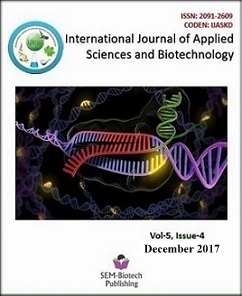Comparison of Feeding Value of Some Popular Tree Fodders for Goats in the Mid-hill Region of Nepal
DOI:
https://doi.org/10.3126/ijasbt.v5i4.18401Keywords:
Tree fodders, nutrient composition, digestibility, voluntary intake, average daily gainAbstract
Large numbers of species of tree fodder are being used as green roughage source for goats in several farming systems. A study was carried out at Goat Research Station, Bandipur, Nepal in order to compare the feeding value of commonly used tree fodder leaves in mid-hills of Nepal. Altogether five treatments; tree fodder leaves of Ficus semicordata, Shorea robusta, Ficus glaberrima and Ficus lacor and mixed fodder as the conventional practices of the farmers were evaluated in Randomized Complete Block Design (RCBD) with three replications. Total of 30 male goats were used for the experiment in five groups, 6 for each treatment. The subsequent experiment was carried out to determine the nutrient digestibility of the tree fodder leaves by using fecal collection method. Nutrient composition, voluntary intake and nutrient digestibility of the fodder leaves and growth performance of goats were monitored. Crude protein (CP), total ash (TA), organic matter (OM), neutral detergent fiber (NDF), acid detergent fiber (ADF), acid detergent lignin (ADL), hemicelluloses and cellulose proportion were better for F. glaberrima and F. lacor leaves, whereas the digestibility of those nutrients were better for F. semicordata leaves and moderate for F. glaberrima and S. robusta. Voluntary fodder dry matter intake was highest for F. glaberrima and least for mixed fodders. Growth performance of goats was higher for F. lacor and F. glaberrima than other tree fodder leaves and mixed fodders. The leaves of F. lacor and F. glaberrima had shown better feeding value than the conventional practices of farmers, mixed fodders. The leaves of S. robusta and F. semicordata were observed similar with the mixed fodders for their feeding value.
Int. J. Appl. Sci. Biotechnol. Vol 5(4): 442-448




